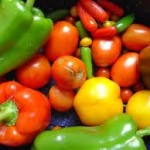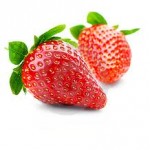Foods that are rich in Iodine
Iodine is an essential nutrient that is very beneficial to the body, more specifically to thyroid function. Iodine’s biggest role is to regulate the production of thyroxine (T4) and triiodothyronine (T3). These two thyroid hormones not only are essential for metabolic activity but also help keep your organs (brain, liver, heart, etc) functioning properly.
The National Institutes of Health recommends that an average adult takes in 150mcg (micrograms) of iodine. It is important to note that there is such thing though as taking in too much iodine. The side effects of an excess of iodine are very similar to being deficient so it is important to stay within the healthy daily amount.
Water Sautéing
 A basic cooking technique used in some recipes is water sautéing. This is used instead of cooking with oil. Water sautéing is simple and good for stir-fries, sauces, and many other dishes. To water sauté, heat a skillet on high heat until water sputters when dropped in the pan. Use small amounts (two to three tablespoons) of water in the skillet, wok, or pan, covering the pan occasionally and adding more water as necessary until the vegetables are tender. If stir-frying a vegetable dish, other alternatives to oil include no-salt vegetable broth, coconut water, wine, or fruit juice.
A basic cooking technique used in some recipes is water sautéing. This is used instead of cooking with oil. Water sautéing is simple and good for stir-fries, sauces, and many other dishes. To water sauté, heat a skillet on high heat until water sputters when dropped in the pan. Use small amounts (two to three tablespoons) of water in the skillet, wok, or pan, covering the pan occasionally and adding more water as necessary until the vegetables are tender. If stir-frying a vegetable dish, other alternatives to oil include no-salt vegetable broth, coconut water, wine, or fruit juice.
Cooking Beans
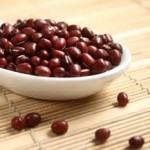 It is advisable to soak most dried beans or legumes overnight before cooking.
It is advisable to soak most dried beans or legumes overnight before cooking.
Replace the soaking water with two to three cups of fresh water for each cup of beans when cooking them. Most beans require about one and a half to two hours of cooking to become soft. Lentils and split peas require only one hour and need not be soaked prior to cooking.
Make sure the beans are thoroughly cooked, as they are more difficult to digest when undercooked. Always keep in mind that it is important to chew them thoroughly. As you get into the habit of eating more beans regularly, you will digest them better. Your good bacteria in your digestive track will need to get conditioned to digesting increased amounts of beans. Any discomfort will eventually go away.
Seed Facts
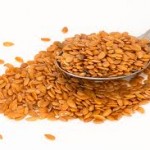 Flax seeds are loaded with omega-3 fatty acids (essential for good health). They are also rich in anticancer lignans, and their mucilage lubricates and eases bowel movements. Flax seeds and sesame seeds contain more lignans than any other food. These plant compounds bind to estrogen receptors and interfere with the cancer-promoting effects of estrogen on breast tissue. They also have a strong anti-oxidant effect. If you choose not to use them whole, it is best to grind your own at home. Keep them in the freezer to retain their freshness. Scientific studies reveal that when flax seeds are given to women with breast cancer, the women show reduced tumor growth and enhanced survival rate, compared to women not given flax seeds.
Flax seeds are loaded with omega-3 fatty acids (essential for good health). They are also rich in anticancer lignans, and their mucilage lubricates and eases bowel movements. Flax seeds and sesame seeds contain more lignans than any other food. These plant compounds bind to estrogen receptors and interfere with the cancer-promoting effects of estrogen on breast tissue. They also have a strong anti-oxidant effect. If you choose not to use them whole, it is best to grind your own at home. Keep them in the freezer to retain their freshness. Scientific studies reveal that when flax seeds are given to women with breast cancer, the women show reduced tumor growth and enhanced survival rate, compared to women not given flax seeds.
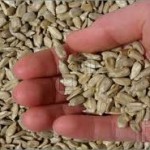 Sunflower seeds are extremely rich in vitamin E, selenium, iron, and other minerals. With 22 percent of calories from protein and rich in the amino acid tryptophan, sunflower seeds are a healthy way that vegetarians, vegans, flexitrians (near-vegans) and nutritarians (people that eat very low amounts of animal products) can ensure that they get sufficient protein.
Sunflower seeds are extremely rich in vitamin E, selenium, iron, and other minerals. With 22 percent of calories from protein and rich in the amino acid tryptophan, sunflower seeds are a healthy way that vegetarians, vegans, flexitrians (near-vegans) and nutritarians (people that eat very low amounts of animal products) can ensure that they get sufficient protein.
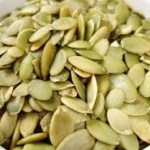 Pumpkin seeds are a good source of omega-3s, are high in phytochemicals, and are rich in zinc, calcium, and iron.
Pumpkin seeds are a good source of omega-3s, are high in phytochemicals, and are rich in zinc, calcium, and iron.
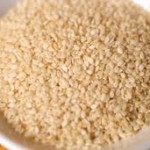 Sesame seeds have the highest level of calcium of any food in the world.They not only have a highly absorbable full spectrum of various vitamin E fractions, but they increase the bioactivity of vitamin E in the body.
Sesame seeds have the highest level of calcium of any food in the world.They not only have a highly absorbable full spectrum of various vitamin E fractions, but they increase the bioactivity of vitamin E in the body.
Weekly Shopping List
 Always keep a good assortment of healthy food in the house. A key to success is having the right kind of food. I suggest the following:
Always keep a good assortment of healthy food in the house. A key to success is having the right kind of food. I suggest the following:
Vegetables to be eaten raw: carrots, celery, peppers, tomatoes, cucumbers, mushrooms, lettuce and other salad greens, snow peas, sugar snap peas, and tomatoes.
Vegetables for cooking: (fresh or frozen) – broccoli, cauliflower, eggplant, mushrooms, tomatoes, cabbage, string beans, kale, Swiss chard, mustard greens, spinach, Brussels, sprouts, asparagus, onions, and garlic.
Fruits (fresh or frozen): strawberries, blueberries, raspberries, kiwifruit, apples, oranges, pineapple, melons, lemons, limes, grapes, pears, bananas, mangoes, plums, peaches, and cherries
Raw nuts and seeds: walnuts, almonds, cashews, pistachios, sunflower seeds, pumpkin seeds, unhulled sesame seeds, hemp seeds, flaxseeds, and chia seeds.
Ingredients for homemade soup: carrots, celery, garlic, onions, zucchini, fresh and dried herbs, no-salt seasoning, leeks, turnips, dried beans, lentils, and split peas.
Other staples: flavored and balsamic vinegars, lemons (juice is great in a salad, soup, or vegetable dish) tomato sauce (no salt added), salsa (no salt added), avocados, tofu, edamame (green soybeans), and old – fashioned rolled oats.
Fresh or diced herbs and seasonings: basil, oregano, dill, parsley, cilantro, chives, rosemary, thyme, ginger, garlic cloves or garlic powder, onion powder, mint, chili powder, cumin, Cajun seasoning, pepper, curry powder, cinnamon, Mrs. Dash (no salt added)



